Misc
HORROR 101: The Origins of the Xenomorph

Welcome back to Horror Press’s Horror 101, a series of articles where we explain horror movie legends and their lore. For beginners, the confused, or just those who need a refresher, these articles are for you. Today we delve into an antagonist described as “the perfect organism” with a “structural perfection [that’s] matched only by its hostility”, the Xenomorph from the Alien franchise. An alien species that’s oft imitated but never surpassed by its many pop culture counterparts, H.R. Giger’s iconic design evolved into a creature shrouded in as much mystery as its costume is in KY Jelly.
While the Alien franchise is quite sprawling, we will only look at the mainline Alien films for canonical explanations of all our questions. As much as I’d love to include the stellar Dark Horse comics and the Alien: Isolation game, we’ll have to touch on those another day.
So how did the Xenomorph come to be, and what exactly is it? Let’s find out.

WHAT ARE XENOMORPHS?
Depending on who you ask, they’re either the worst or greatest thing to happen to the galaxy at large. What the android Ash calls “A survivor, unclouded by conscience, remorse, or delusions of morality”, the Xenomorph is driven only by primal instincts to kill and reproduce at high speeds.
The xenomorph is the byproduct of a bioweapon called “the black liquid, ” or, more commonly by fans, the black goo. Through genetic experimentation, the xenomorph was engineered as a killing machine with peak agility and strength. Most xenomorphs stand around 6’10”, and sport an iconic, shiny black exoskeleton that grants them unbelievable durability.
Among its most distinctive features are a lack of eyes, a second set of inner jaws that can punch through reinforced glass and metal, and a bladed tail. Bright green acidic blood, capable of burning through almost anything, makes it borderline impossible to engage at close quarters without harming yourself.
HOW DO XENOMORPHS REPRODUCE?
Its most frightening and iconic quality, however, is its reproductive cycle.
When a living being approaches a xenomorph egg, a spiderlike “face-hugger” leaps out and attaches to living prey to implant an embryo orally. Within a matter of hours, the embryo develops into a self-sufficient juvenile alien that forcibly (and fatally) claws out through the torso of the victim, earning it the nickname “chest-burster”. It then grows into a fully-fledged drone, or a queen that produces more eggs.
Xenomorphs, by their nature are incredibly adaptive parasites, able to gestate in any living mammal that can sustain its egg. These xenomorphs will also take on the traits of their hosts; The Dragon from Alien 3 was spawned from an ox and was uniquely quadrupedal as a result.
WHO CREATED THE XENOMORPHS?
To get to the bottom of that, we need to explain the black goo and who made it!
WHAT IS THE BLACK GOO, AND WHO MADE IT?
Introduced posthumously in Alien, then later fully in Prometheus, the Engineers were an advanced alien species that seeded life on many planets, including the building blocks of human life on Earth. However, when the Engineers were unhappy with their creations, they would deploy a devastating planetary bioweapon to depopulate entire worlds of species that they deemed “mistakes”. This was the black goo.
Its most notable user is David, a malicious android made by the Weyland-Yutani Corporation and modeled after founder Peter Weyland. He is also the predecessor of the androids Ash and Bishop from Alien, Aliens, and Alien 3, and a brother model to the android Walter from Alien: Covenant.
David studied the black goo extensively following his encounter with its creators in Prometheus and the subsequent attack on their homeworld (Planet 4) in Alien: Covenant. As per the short film Alien: Advent, his research claims that the black goo was made up of “advanced nano-particles” which he considered biomechanical artificial intelligence. Like a slime mold in motion, the black goo has some senses and intentionally seeks out organic targets; this is most evident in the bombing scene from Alien: Covenant, where it tears through crowds of Engineer civilians.
The black goo AI would model itself after natural evolutionary development, curate the genes most likely to succeed, then accelerate the process by mutating those traits instead of waiting for hundreds of generations to develop them. The resultant mutations would usually be too intense and liquefy their targets from the inside out.
The operative word is usually.
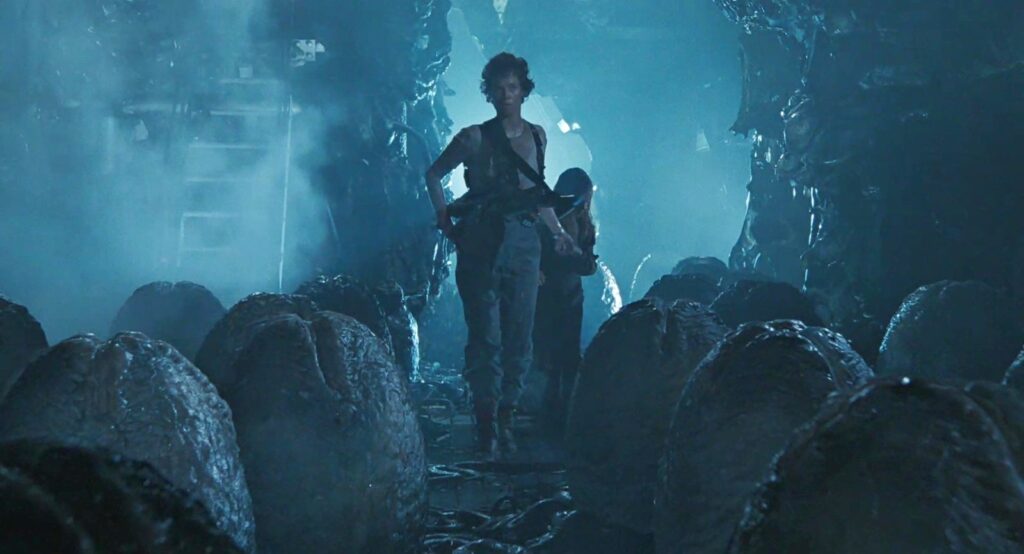
OKAY, THERE, NOW WHO CREATED THE XENOMORPHS?
David recognized the limitless potential of dynamic DNA that could rapidly mutate on command. He began to engineer the black goo with the insects and plant life that survived his attack on Planet 4.
In Alien: Advent David began using selective breeding to steer small amounts of the black goo into making him a species designed to expand across the galaxy, though most early attempts are failures. By the time of Alien: Covenant, he makes the dream a reality, and the first face-hugger eggs are made, resulting in the creation of a fully-fledged xenomorph (dubbed the Neomorph) via a human host. He later stored other eggs in a ship headed for Earth on behalf of the Weyland-Yutani Corporation, but their fate is currently unknown.
However, David was not the only one to succeed in this. In Alien and Aliens, a separate vessel piloted by long-dead Engineers had crashed on the exoplanet LV-426, carrying similar fully formed eggs. One surviving egg spurs the events of the first film, while a dormant hive would cause chaos in the second. This would mean the Engineers also managed to create near-identical xenomorphs independent of David’s actions.
In short: The Engineers and David both used the black goo to make parallel versions of the xenomorphs, but there’s no reason why the xenomorphs couldn’t have sprung up on other worlds through the tampering of other species.
It’s also why I believe the Alien vs. Predator films are canon because the Yautja could have done the same process with their tech.
Let me believe.
I have to believe.
WHY DID DAVID MAKE THE XENOMORPHS?
David’s first encounter with an Engineer in the film Prometheus not only resulted in his head getting ripped off, but also broke his heart too.
Prometheus showed that the Engineer planned on destroying Earth after it was woken up from its slumber. When the failed Prometheus mission dissolved as a result, David became disillusioned. According to Ridley Scott, through having met his maker’s maker, he grew to resent both Engineers and Humans and sought to supplant them as creators. Hence, bombing Planet 4 and the subsequent xenomorph project.
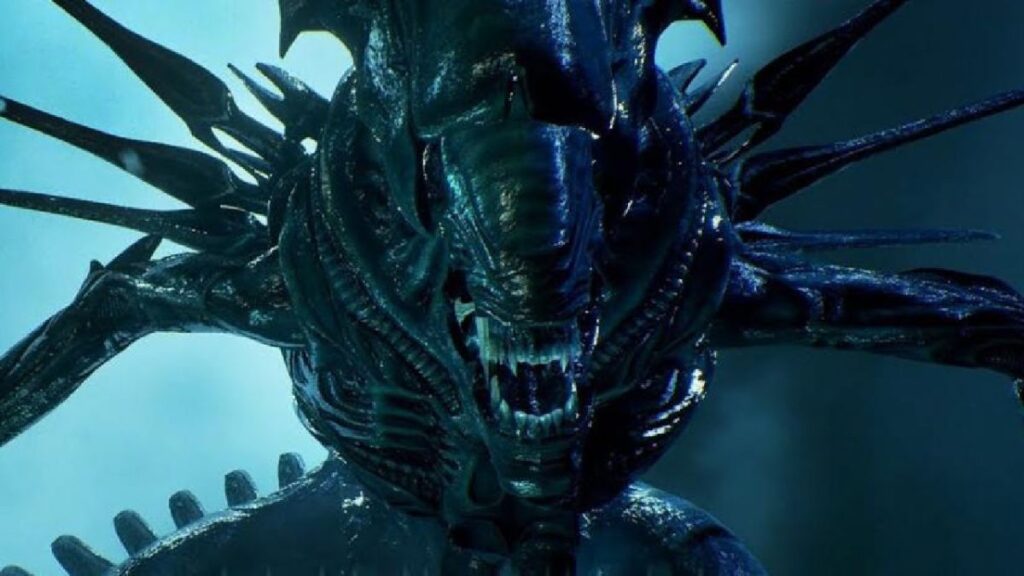
WHY ARE THE XENOMORPHS SO BUGLIKE?
They’re wasps. Like, the bug, not protestants.
Outside of the obvious design inspiration insects serve for these often-hunted bugs, the first successful Xenomorph created by David was derived primarily from the wasps on the untitled Planet 4 that he bombed with the black goo. He called these insects the “shock troops of the genetic assault”, as they developed the features most similar to the face hugger, able to implant new parasitic offspring that would take on traits of the host.
This also explains why the xenomorphs make hives out of every place they dwell in, plastering the walls with organic insulation like a paper wasp would with dead plant material.
HOW DO YOU KILL A XENOMORPH?
Not to insult a fictional android, but David’s perfect galaxy-controlling weapon has a few blind spots.
Xenomorphs may not explicitly be anymore weak to fire than a human would be, but it is undoubtedly the only weapon that they’ll actively avoid contact with. Horror Hall of Famer and protagonist of the first four films, Ellen Ripley, uses a flamethrower against them to great effect. She also incinerates her first alien with the thruster of the Nostromo’s escape shuttle.
And despite how powerful they are on the outside, shots aimed inside the mouth, like Hicks’ messy shotgun blast from Aliens can bypass it. Explosives like the grenades in Alien: Resurrection, or enough gunfire from a pulse rifle can mulch them into green paste. Make sure not to step in said paste. And hey, if all else fails…
Misc
Our Halloween Giveaway Is Here!
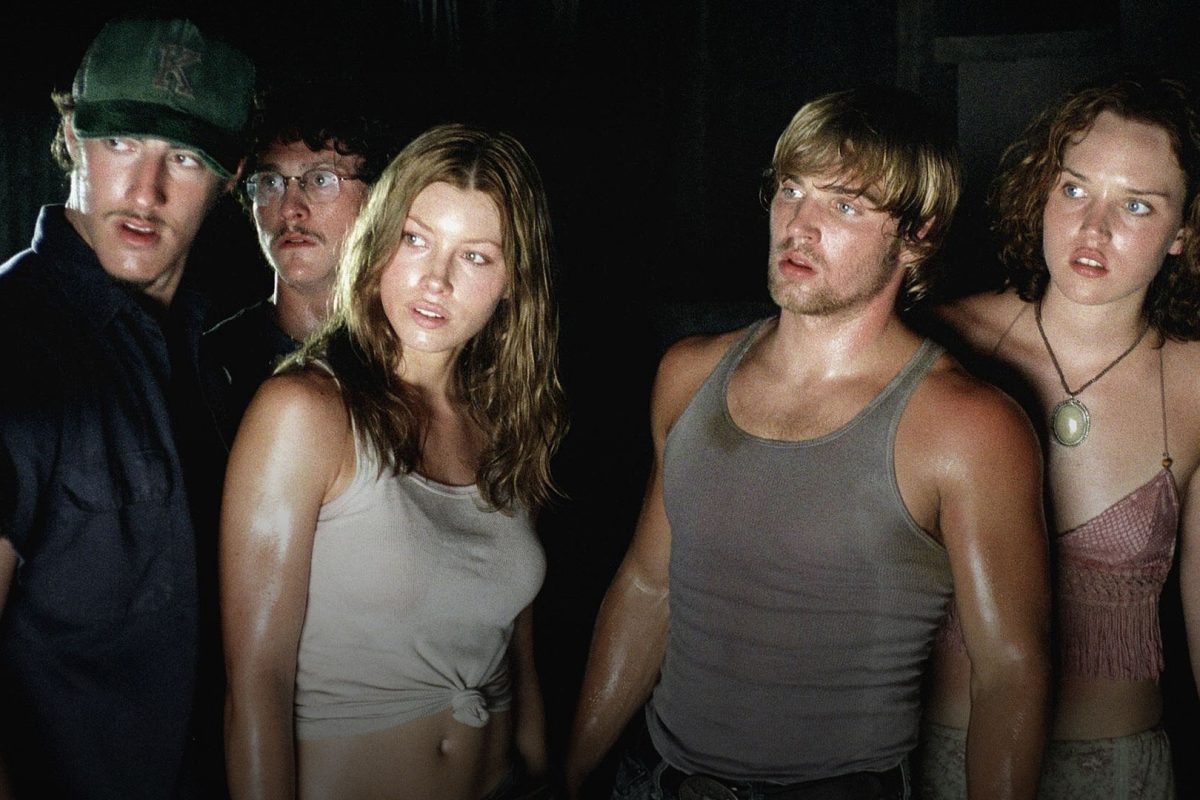
Enter Our Halloween Giveaway!
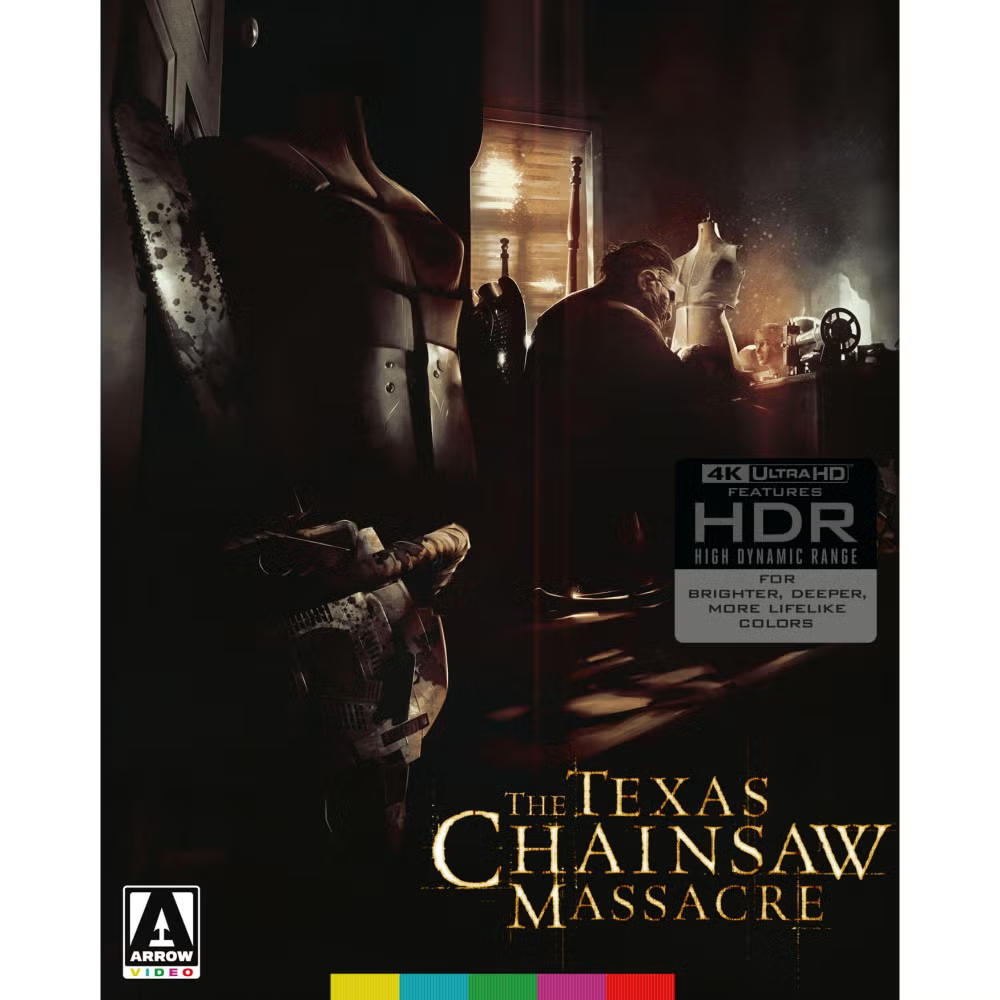
How to Enter:
Step 1. Make sure to FOLLOW US ON FACEBOOK AND JOIN OUR FACEBOOK GROUP!
Step 2. LIKE AND SHARE the giveaway post!
Step 3. This is the most important step, email us at contact@horrorpress.com with your FULL Facebook name (so we can verify you’re in the group) and who your favorite character is from the Texas Chainsaw franchise.
**Giveaway entries are limited to addresses in the United States.**
**All entries must be 18 or older to enter**
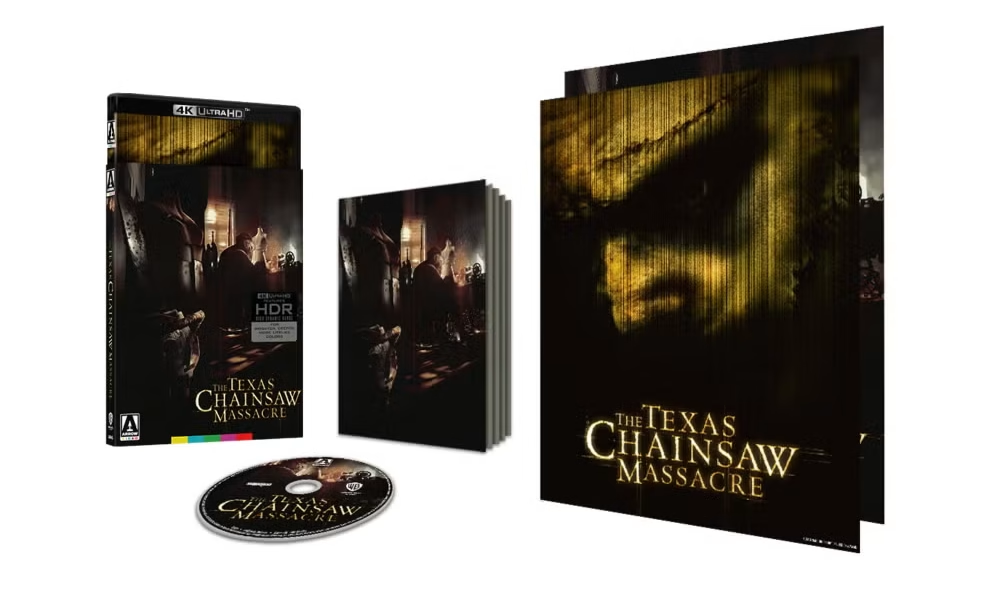
What You’ll Win
The Texas Chainsaw Massacre (2003) Limited Edition 4K UHD from Arrow Video
- 4K (2160p) Ultra HD Blu-ray presentation in Dolby Vision (HDR10 compatible)
- Original DTS-HD MA 7.1 and 5.1 surround audio and lossless stereo audio
- Optional English subtitles for the deaf and hard of hearing
- Brand new audio commentary with Dread Central co-founder Steve “Uncle Creepy” Barton and co-host of The Spooky Picture Show podcast Chris MacGibbon
- Archival audio commentary with director Marcus Nispel, producer Michael Bay, executive producers Brad Fuller and Andrew Form and New Line Cinema founder Robert Shaye
- Archival audio commentary with Marcus Nispel, director of photography Daniel Pearl, production designer Greg Blair, art director Scott Gallager, sound supervisor Trevor Jolly and composer Steve Jablonsky
- Archival audio commentary with Marcus Nispel, Michael Bay, writer Scott Kosar, Brad Fuller, Andrew Form and actors Jessica Biel, Erica Leerhsen, Eric Balfour Jonathan Tucker, Mike Vogel and Andrew Bryniarski
- Reimagining a Classic, a brand new interview with director Marcus Nispel
- Shadows of Yesteryear, a brand new interview with cinematographer Daniel Pearl
- The Lost Leatherface, a brand new interview with actor Brett Wagner
- Masks and Massacres, a brand new interview with makeup effects artist Scott Stoddard
- Chainsaw Symphony, a brand new interview with composer Steve Jablonsky
- Chainsaw Redux: Making A Massacre, a making-of documentary
- Ed Gein: The Ghoul of Plainfield, an in-depth look at the infamous killer who inspired the character of Leatherface
- Severed Parts, a look at the cutting room floor and some of the scenes excised from the final edit
- Deleted scenes including an alternate opening and ending
- Screen tests for Jessica Biel, Eric Balfour and Erica Leerhsen
- Behind-the-scenes featurette
- Cast and crew interviews
- Theatrical trailers and TV spots
- Concept art galleries
- Reversible sleeve featuring original and newly commissioned artwork by Aaron Lea
- Double-sided foldout poster featuring original and newly commissioned artwork by Aaron Lea
- Illustrated collector’s booklet featuring new writing on the film by Michael Gingold
Misc
NYCC 2025 Horror Highlights: A Sneak Peek at ‘The Lost Boys’ Musical, ‘Resident Evil: Requiem,’ and More!

As soon as New York Comic Con announced that its 2025 theme would be “haunted,” I started lacing up my comfy shoes and making a beeline for the Javitz Center! Horror has always been represented at the con, but it felt fitting that it should play a central role in this year’s event at a time when the genre seems more popular than ever.
From beloved family-friendly properties like The Nightmare Before Christmas to pants-dampening titles like the upcoming Resident Evil: Requiem, horror appeared in countless shapes and forms. Here are all the best and scariest insights I gleaned from the show floor, panel rooms, and pop-ups of New York Comic Con 2025!
Our NYCC 2025 Horror Highlights
Resident Evil: Requiem Is Going to Test Your Bladder Strength
Full disclaimer: I’m not a gamer. I’m honestly pretty bad at games, which made my Resident Evil: Requiem play session all the more frightening because I was convinced that everyone around me would realize I’m a fraud. But with easy-to-grasp controls, even for a newb like me, the latest installment in the iconic horror franchise quickly sucked me in and left me on edge for entirely different reasons.
During my 30-minute session, I was introduced to FBI analyst Grace Ashcroft, Requiem’s central character. She swims to consciousness to find herself strapped upside down on a gurney with a needle in her arm, siphoning her blood. After Grace managed to free herself, the controls were handed over to me to explore the creepy facility through Grace’s eyes, looking for a fuse. Some spaces were bathed in red light; others were lit only by flickering bulbs that left me white-knuckling the controller, waiting for something to emerge from the shadows and swallow me whole, not helped by Grace’s anxious, stuttering breathing in my ear.
I took a moment to appreciate how detailed video games have become since my childhood experiences playing Evil Dead: Hail to the King on the original PlayStation (seriously, you can see the dust drifting in beams of light now?!), only for the sound of movement somewhere in the facility to yank me back to the present. I renewed my frantic search for the fuse, only to run blindly into a pitch-black room and encounter something enormous that dragged me into the darkness. Sorry, Grace!
You can find out what happens next when Resident Evil: Requiem releases for the PlayStation 5, Xbox Series X|S, PC, and Nintendo Switch 2 on February 27, 2026.
Megan Fox Is Among the New Cast Members in Five Nights at Freddy’s 2—And Blumhouse Hasn’t Given Up on Its Other m3gan Yet
Blumhouse made several announcements at their NYCC panel, most notably that Megan Fox (Jennifer’s Body) is voicing Toy Chica in director Emma Tammi’s highly anticipated sequel Five Nights at Freddy’s 2, coming to theaters on December 5. Other new additions to the cast include YouTuber Matthew Patrick, aka MatPat, who cameoed in the first movie and will voice Toy Bonnie, and Kellen Goff, who has voiced multiple characters in the game series and will now lend his pipes to Toy Freddy.
I’m interested in Five Nights at Freddy’s 2, not least because my best friend is terrified of the franchise and makes a wildly entertaining moviegoing companion—but I’m more interested in the future of another Blumhouse franchise, M3GAN. After the sequel underperformed, likely due in part to its hard genre pivot away from horror and into action territory, the future of the killer doll is uncertain. But in a special industry presentation on “The Business of Fear,” Jason Blum revealed that “we’re all working to keep M3GAN alive,” adding that Blumhouse is exploring other potential mediums before trying to resurrect her on film.
Does that mean a M3GAN video game might come our way in the future, or perhaps a TV series? I don’t know, but I have a feeling this isn’t the last we’ve seen of the silicone diva.
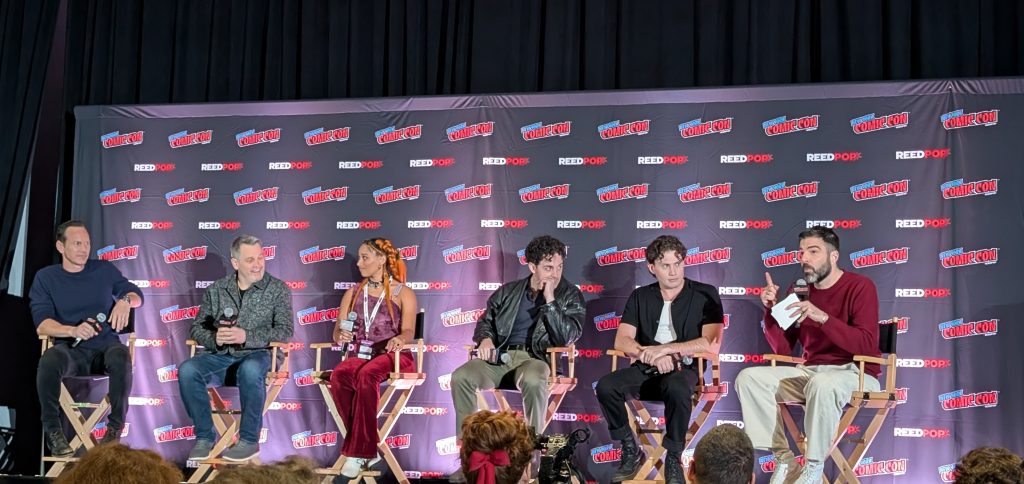
Photo taken by Samantha McLaren.
The Lost Boys: A New Musical Will Feature Flying Stunts and a Live Vampire Band
My queer heart is a sucker for musical adaptations of horror films I love, so you can be certain that I’ll be heading down to the Santa Carla Boulevard—aka Broadway’s Palace Theater—for The Lost Boys: A New Musical, which begins previews on March 27, 2026. At their NYCC panel, producer Patrick Wilson (The Conjuring franchise), director Michael Arden (Maybe Happy Ending), and cast members LJ Benet, Ali Louis Bourzgui, and Maria Wirries revealed why they feel Joel Schumacher’s 1987 classic translates so well to the stage, and what audiences can look forward to.
“There’s something that I see with both horror movies, musicals, and superhero movies—there’s an element of melodrama that’s really rewarding,” says Wilson, who began his career in musical theater and worked with Schumacher on the director’s 2004 film adaptation of The Phantom of the Opera. “Some people view it as camp, but there’s a reality of it being heightened that felt like this story cemented itself so much to being a musical.”
“They’re a biker gang, after all, and there’s a level of theatricality to that in and of itself,” says Arden. “Our biker gang also happens to play instruments.”
That’s right: the vampires will be playing instruments live on stage, which made casting twice as hard. Ali Louis Bourzgui, who plays David, the character portrayed by Kiefer Sutherland in the film, reveals that he plays guitar. And that wasn’t the only unusual request in the casting call: auditions included a flying test. (Presumably wires were involved, unless Arden has found himself a real cabal of vampires in his cast.)
Other highlights that fans can look forward to include killer music from one of Arden’s favorite bands, The Rescues. You can listen to the song “Have to Have You” right now, featuring instrumentals from Slash. The director also teases that many fan-favorite moments from the film will feature in some way in the musical, including the bridge scene and, yes, even the sexy saxophone guy.
Greg Nicotero’s Guts & Glory Marks a New Challenge for a Legend of the Business
If you like looking at gnarly practical effects in horror movies, chances are you’re familiar with Greg Nicotero’s work, whether you realize it or not. The legendary SFX artist has worked on everything from George Romero’s Day of the Dead and Sam Raimi’s Evil Dead II to Kill Bill and, more recently, The Walking Dead. The impressive extent of his resume was made clear at the panel “Shudder is Here to Scare the S*** Out of You,” in which almost any film mentioned by the other panelists was met by a small smile and a humble murmur of “worked on that” into the mic, often followed by a wild anecdote. Nicotero seems like the most interesting man in the world to grab a drink with, and his new horror competition show for Shudder—Guts & Glory—will let us see more of the man behind the makeup brush.
“Guts & Glory is one of the most fun times I’ve had on a show,” Nicotero says, teasing that the series is “part Sam Raimi, part Halloween Horror Nights, and part Survivor.”
In the six-episode first season, contestants are dropped into an Alabama swamp, where there’s an urban legend about an evil spirit. “One of the contestants gets possessed by the evil spirit, people start dying off, but in the meantime, they’re still competing and there’s a prize,” Nicotero explains.
Guts & Glory is effects-heavy, which was challenging to do in an unscripted series relying on real people’s real-time reactions. “You do a movie, you can cut and try it again,” Nicotero explains. “[This] was completely out of my wheelhouse and out of my comfort zone, but I’m really, really proud of it.”
Nicotero’s Creepshow was one of the first original shows to debut on Shudder, so he’s truly part of the DNA of the horror streamer, which celebrated its 10th anniversary this year. Guts & Glory premieres on October 14 as part of Shudder’s Season of Screams programming.
Horror Short The Littles Deserves the Big-Screen Feature Treatment
Some short films are perfectly suited to their bite-sized format, while others contain the seeds of something much bigger. At the New York Premiere of The Littles, a new short written and directed by American Horror Story producer Andrew Duplessie, I could immediately see the potential for the feature film that Duplessie hopes to make.
Equal parts charming and unsettling, The Littles stars M3GAN’s Violet McGraw as a little girl with a loose floorboard in her bedroom. One night, a scuffling sound and a crack of light between the boards lead the little girl to discover that her family isn’t alone in the house…
Duplessie says The Littles was inspired by his own experiences growing up in a creaky old house with a no-doubt overactive imagination. The short features creepy-cute stop-motion animation from Anthony Scott (The Nightmare Before Christmas), puppets by Katy Strutz (Guillermo del Toro’s Pinocchio), and some truly adorable miniature sets by Aiden Creates, all blended perfectly with the live-action scenes. Check it out if it’s playing at a festival near you, and watch this space for a (fingers-crossed) future feature!
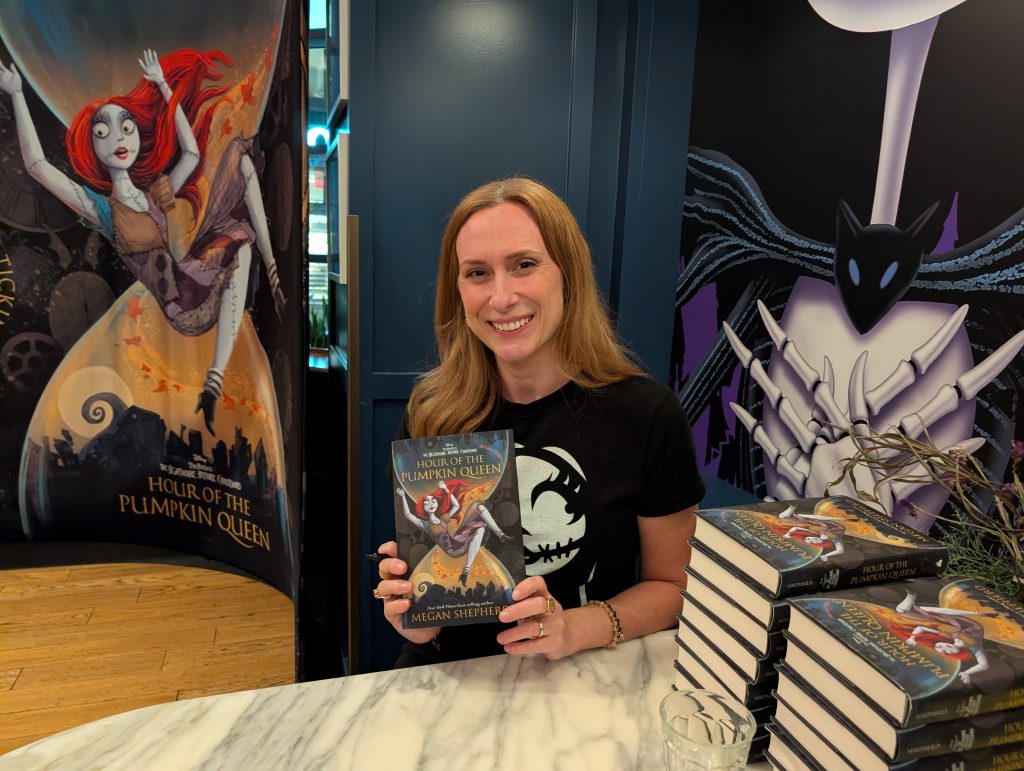
Photo taken by Samantha McLaren.
Disney Publishing’s New The Nightmare Before Christmas Tie-in Novel Welcomes Younger Fans into the Scary Fun
NYCC’s horror happenings weren’t all geared toward an adult audience. Disney Publishing took over Daily Provisions Manhattan West for a pop-up experience inspired by The Nightmare Before Christmas, featuring themed food and drinks like a delectable Pumpkin Potion coffee that I could honestly drink all season long.
At a media and creator event in the space, I took a look at the newly released Hour of the Pumpkin Queen from New York Times best-selling author Megan Shepherd, who also wrote the official novelization of The Nightmare Before Christmas for the film’s 30th anniversary in 2023. In this new tie-in novel, Sally and her rag doll apprentice, Luna, embark on a time-bending adventure to save Jack Skellington and Halloween Town after falling through a mysterious portal.
I was gifted a copy of the book by Disney, but all opinions are my own here. I’m looking forward to giving it a read during the inevitable Halloween hangover that takes place in November, before likely passing it on to my young nieces when they’re old enough. It’s a full novel, not a picture book, so definitely geared more toward a YA audience, but between the beautiful artwork on the cover and the seasonal theme, it might just be the perfect gift for the budding horror lover in your life.
That’s a wrap on New York Comic Con 2025! Be sure to bookmark Horror Press if you haven’t already so you never miss our coverage of conventions, festivals, and more.

























